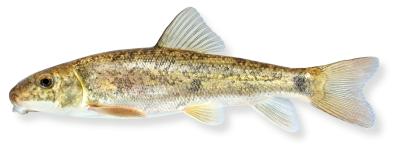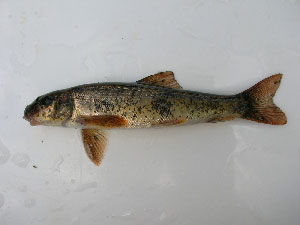White Sucker
Catostomus commersoni
 Distribution: Whitesuckers range from Labrador west to British Columbia and south along the eastern slope of the Rocky Mountains to New Mexico. They are found throughout most of the Mississippi River valley and the east coast south to Georgia. They are found in all freshwater habitats in New Hampshire.
Distribution: Whitesuckers range from Labrador west to British Columbia and south along the eastern slope of the Rocky Mountains to New Mexico. They are found throughout most of the Mississippi River valley and the east coast south to Georgia. They are found in all freshwater habitats in New Hampshire.
Description: A cylindrical fish with a blunt snout and a downward pointed fleshy mouth adapted for bottom feeding. The scales are relatively large and visible, but not as large as those of the fallfish. Adults are black to brass colored on the back with a cream colored underbelly. Juvenile white suckers are more mottled in coloration. During spawning, males grow coarse tubercles on their fins and become reddish in color along their sides.
Species commonly confused with: Longnose sucker
Habitat: Freshwater rivers, streams, lakes, and ponds of all sizes.

Life History: Common white suckers are one of New Hampshire’s most abundant freshwater fish species. Extremely adaptable, they can be found in almost any habitat type. Larger individuals prefer lakes, ponds, or deeper sections of rivers and streams. In the spring, white suckers migrate into swift flowing streams with gravel bottoms to spawn. Migration usually begins when water temperatures reach 50°F. Juvenile suckers are found in streams of all sizes where they forage along the bottom for invertebrates and algae. White suckers are an important forage species for many predators. Adult white suckers are generally between 10 and 18 inches (255 and 460 mm) long, but some individuals can grow as large as 2 feet (600 mm) in length.
Origin: Native
Conservation/Management: There are no specific conservation or management objectives for white suckers. As a relatively long-lived and abundant species, white suckers have the potential to be indicators of aquatic ecosystem health, but their value as indicators is offset by their tolerance of low oxygen levels and habitat disturbance. White sucker spawning runs are often limited by impassable stream crossings, which prevent fish from accessing the gravel-bottomed rivers and streams where they prefer to spawn.



